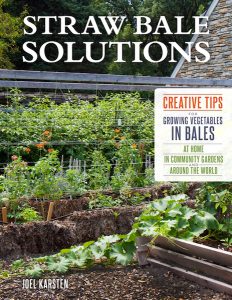+86- 111****
Boluo county dragon Lotus Lake Village Town Industrial Park, China

As gardeners await the spring gardening season to hit its stride, I’m considering exploring a new vegetable garden technique: the straw bale. It’s exactly what it sounds like—growing plants using a straw bale as the place from which plants grow. A new book by the person who brought straw bale gardening to the forefront Joel Karsten, Straw Bale Solutions (Cool Springs Press, 2018), explains both the method for using and growing in straw bales and how straw bales can help solve some gardening space problems in a number of different situations.
My mother, who is in her 80s, does enjoy fresh fruits and veggies, and misses the days she and my father had a sprawling near-acre vegetable garden adjacent to their farm. With Dad gone and Mom a bit wobbly on her own feet, she was considering having us children build her a raised bed on a cement slab outside her back door. We’d have to buy wood and landscape fabric, build the structure … and then pay for good soil to fill it up. It would not be cheap, I reminded her.
Then Joel’s book reminded me that straw bale gardening was not only an option for growing on my Mom’s cement slab, it was a more affordable option. My brother, who now runs the family farm, has a good supply of straw bales at the ready. Straw bale gardening, here we come.
First the Conditioning
Joel’s first book, Straw Bale Gardens published in 2012, introduced the world to the concept of and techniques for growing in straw bales. Chapter 2 of Straw Bale Solutions offers a thorough review of the techniques presented in that first book. The revelation presented here is that when growing in straw bales, you’re not growing in straw. Rather, you’re growing in recently decomposed straw. By “conditioning” the straw bale—i.e. soaking with water and adding nitrogen to kick start the microflora and microfauna into doing their jobs—you start that decomposition process. And in about two weeks, the straw bale is ready for planting. This Chapter 2 goes into a bit of the scientific explanation and process to help folks understand how to do it right. There is even an explanation of what types of bales work best—even those you can make yourself.
Then the Solutions
The rest of the book tells the stories of real-life straw bale gardeners. Each had been presented with a gardening dilemma—the steep slopes of Switzerland, cold-climate gardening in Canada, rocky soils, even no soils—and found their solution in using straw bales. The book also shares stories of successful community straw bale gardening efforts in different parts of the world that aim to alleviate hunger. From Cambodia to Copenhagen, straw bales have helped bridge that gap between an empty plate and a good meal.
The straw bale garden we are planning for my mother’s cement slab not only creates a space for her to garden—it also raises the plants up and off the ground for her. She’ll have less bending to do, and strategically placed trellises and poles will help her plants grow up for easier harvesting. I’m getting excited about this project. Hurry up, spring!
Meanwhile, if you are interested in this book, visit The Quarto Group for ways to purchase.